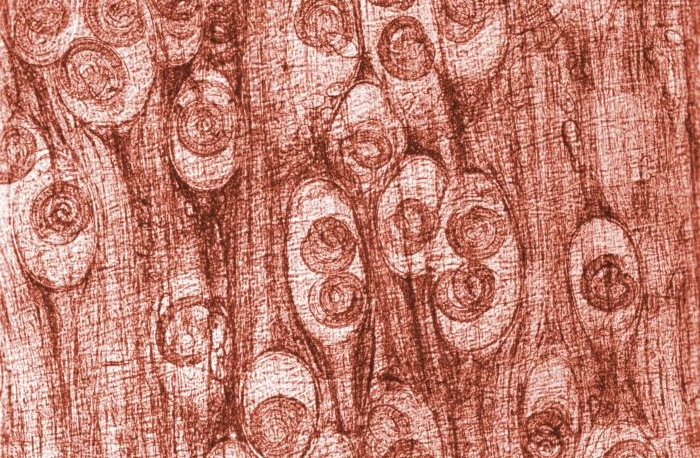Few media-hyped events pose such a lurking, pit-of-your-stomach discomfort as the rapid, global emergence of a new disease. The sound of ambulance sirens, the sight of surgical masks in public transportation, and quarantine signs with biohazard symbols cascade over each other on television and our sympathetic nervous system floods with epinephrine to prepare for an imminent threat that may actually be a world away. In late 2002, a new disease was identified in China that dominated global media for a year. Marked by borderline pandemic spread and ambiguous symptoms, it is still a trigger word in our social consciousness.
By the time the new respiratory disease spread from China’s rural Guangdong Province to the hustle and bustle of Hong Kong and Hanoi, it was featured on nighttime television, but still had no name. At this point in early 2003, 305 had fallen ill, and 5 had died. Healthcare workers started calling the disease “atypical pneumonia.”
The new disease seemed well disguised at first. Doctors warned about flu-like, non-specific respiratory symptoms like coughing, discomfort, and a sore throat, which could progress to pneumonia (a condition that seems to many to be anachronistic, like polio). However, these generic winter symptoms were killing people. Making matters worse, it was February- peak season for these symptoms. Coughing and sore throats were everywhere in America. This new outbreak was personally threatening. It didn’t seem to Americans like cholera in Nepal or typhoid in Africa, both of which our well-developed sanitation systems could stop. The new disease seemed to equalize the socioeconomic and infrastructure playing fields.
On March 10, 2003 the new syndrome was labeled severe acute respiratory syndrome, or SARS. Two days later, the World Health Organization (WHO) issued a global alert. Within that same week, WHO was forced to heighten the alert as more than 100 cases were identified in Singapore, as well as four cases in Canada. SARS was crossing the globe with panic-inducing speed. However, by the end of the month, experts started to catch up with their novel pathogen. Scientists in Hong Kong and the CDC announced SARS to be a new coronavirus and, using the same powers of globalization that SARS seemed to employ to spread so quickly, remotely connected 80 clinicians from thirteen countries to develop a uniform treatment plan and a new serum test – the first option for lab-based confirmation of a SARS case.
Critics decried the progress as too slow. After all, in just five months SARS broke into several countries and both hemispheres before we could even prove someone had it. This criticism raised another question, one that permeated from the base rock of the world’s anxiety: how is SARS spreading so fast?
At this point in the spring of 2003, scientists were unclear as to exactly how infectious SARS actually was. Anecdotal evidence suggested “very infectious.” As a result, new clusters of SARS in Hong Kong were isolated. Sometimes even entire neighborhoods were relocated into rural isolation camps replete with the ancillary apprehension of people trucked away to guarded sites for quarantine. In movies, that is a bad indicator for the government’s control of any disease. In May, Time Magazine featured a blue-eyed face hidden behind a respiratory mask. The title read “The Truth about SARS” and, based on what amounted at that point to be 4,800 cases in 26 countries, claimed “so far, the US has been lucky”.
In labs and offices, epidemiologists scrambled to describe the epidemic in rigorous mathematical terms. By May, after models and mapping, it appeared that the reproductive number – the number of people one person with SARS would infect – was around two to four.. As a point of reference, measles has a reproductive number around 10-15. From observation of communities in Hong Kong, two to four people made sense once the disease infiltrated a group and spread through close person-to-person contact, but it did not account for the spread into so many new countries. As 1,000 bed hospitals were constructed specifically for SARS patients in Beijing, a new theory on the spread of SARS emerged: super spreaders.
Typically a function of STI transmission, super spreaders often revolve around the 20/80 rule, which means that 80% of infections arise from 20% of the cases. In the SARS epidemic, traveling businessmen and relocated physicians seemed the most likely causes. As a result, travel advisories emerged for areas affected by SARS and the implications of globalization on disease outbreaks crystallized.
As flu season passed in 2003, it was increasingly clear that SARS was manageable with traditional public health measures. Scientists had caught up with the runaway coronavirus, now it seemed they could start pumping the brakes. Isolation camps disappeared and one by one cities fell off the WHO travel advisory list. By the mid-summer, only the occasional case trickled in.
After an explosive start, SARS receded with similar pace. By 2004, the NIH started US vaccine trials, but outside the lab there were no more cases. In China, vaccines were distributed with minimal side effects, but since late 2004, SARS – which killed over 800 people and caused some 8,000 to get ill – has not been seen again.
In its absence, SARS is less a forgotten public health obstacle and more a piece of popular lore. Ten years ago the novel virus garnered the focus of the media, Saturday Night Live skits, and the Canadian SARS Stock Music Festival. Today, SARS stands as a measuring stick for emerging diseases. The identification of a novel coronavirus in the Middle East, though different in transmissibility and its attack on renal function, immediately conjured the glued-to-the-news apprehension of SARS. Indeed, the World Health Organization spokesperson, Gergory Hartl, established in a press conference about the new virus a spectrum for how dangerous a coronavirus can be “ranging from the common cold to SARS.” As a final testament to the clout of SARS, Hartl added, “I need to emphasize again and again that this [the novel coronavirus] is not SARS, it will not become SARS, it is not SARS-like.”

